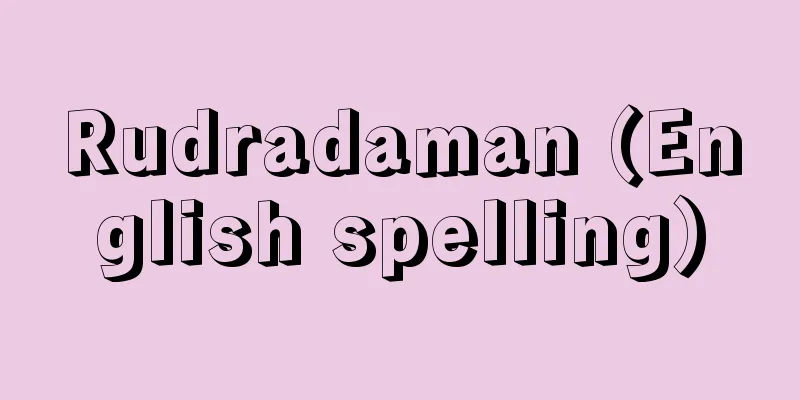Display - Display (English spelling)

|
In the communication between animals, a behavioral pattern that has been exaggerated and ritualized in the course of evolution is called a display. The shape, color, sound, scent, gestures, and behavior of animals serve as releasers that release specific responses in other individuals of the same species. Some of these have led to behavioral specialization, with their functions strengthened and clearer, and the releasers more emphasized. In other words, they have been simplified, some elements have been emphasized, and certain behavioral patterns have been modified to have different meanings, changing them into signals that are more useful in social life, and generally becoming very stereotyped. Many of the behaviors that have become ritualized in this way have their origins in and have developed from behaviors seen in daily life, such as attack, escape, feeding, and preening. They are widely found in the social life of animals, such as courtship behavior, aggressive behavior, and appeasement behavior. Many are innate and species-specific behaviors. Courtship displays attract the opposite sex and have the effect of facilitating reproduction. The zigzag movements that male sticklebacks make towards females are a courtship display that combines aggressive behavior with the behavior of guiding the female to the nest. Similarly, the behavior of male and female little grebes facing each other and holding water plants in their mouths is a courtship display in which nest-building behavior has been ritualized. Courtship feeding, which is widely seen in birds, originates from child-rearing behavior. Bowerbirds build decorated mounds and perform courtship displays there. The brightly colored male birds of paradise dance in front of females. Other courtship displays include beautiful singing and beak-touching. Examples of threatening displays include tropical fish of the Auricularia family that stare at each other with their gill covers fully spread, and territorial male European robins that arch their red-winged chests in response to intruder males. Threatening displays are performed when there is a conflict between the desire to attack and the desire to flee. The behavior of herring gulls uprooting grass during a fight is thought to be a threatening display that has been displaced from nest-building behavior. Dogs that have lost a fight will expose their neck, a vital point, and marine iguanas will prostrate themselves before the winner. These are displays that appease the opponent's aggressiveness, and the winner will immediately cease their attack. By ritualizing fights in this way, injury or death to the combatants is avoided. There are also displays aimed at individuals of different species. For example, a hawk moth displays the eye-like patterns on its hind wings to show predators, and ground-nesting birds pose as wounds to predators approaching their nests. Both of these displays are intended to avoid predation. [Hiroshi Nakamura] "Aggression: The Natural History of Evil, Part III (1970, Misuzu Shobo)" by Lorenz, translated by Toshitaka Hidaka et al. "Introduction to Ethology, Part 1 (1975, Baifukan)" by Manning, translated by Kazuki Hotta et al. "Comparative Ethology, Part 2 (1978, Misuzu Shobo)" by Eibesfeld, translated by Junichiro Itani et al. [References] | |Source: Shogakukan Encyclopedia Nipponica About Encyclopedia Nipponica Information | Legend |
|
動物の個体間で交わされるコミュニケーションにおいて、進化の過程で誇張され儀式化された行動様式をいい、「誇示」と訳す。動物のもつ形態、色彩、音声、香り、身ぶり、行動などは、同種他個体に特定の反応を解発させるリリーサー(解発因)としての役割を果たしている。これらのうちのいくつかのものは、機能の強化、明確さを増し、リリーサーがいっそう強調されるように、行動上の特殊化をもたらしている。すなわち、単純化されたり、一部の要素のみが強調されたり、またある行動型がほかの意味をもつ行動へと修正されることにより、いっそう社会生活に役だつ信号に変化していき、一般にはきわめて型にはまった行動となる。このようにして儀式化されるに至った行動は、その多くが攻撃、逃避、採食行動、羽づくろいなど日常生活でみられる行動に起源をもち、それらから発展したものである。求愛行動や攻撃行動、なだめ行動など、動物の社会生活のなかに広くみいだされる。多くは生得的であり、種に固有の行動である。 求愛ディスプレーは、異性を誘引し、生殖をスムーズに行う効果を果たしている。トゲウオの雄が雌に行うジグザグ運動は、攻撃行動と雌を巣に導く行動が結合した求愛のディスプレーである。また、カイツブリの雌雄が向き合い、水草をくわえて見せ合う行動は、巣づくり行動が儀式化された求愛のディスプレーである。鳥類に広くみられる求愛給餌(きゅうじ)は育児行動に由来する。ニワシドリの仲間は、飾りたてた塚をつくり、そこで求愛のディスプレーを展開する。はでな色彩をしているゴクラクチョウ類の雄は、雌の前で踊る。このほか、美しくさえずったり、嘴(くちばし)に触れたりする行動も求愛のディスプレーである。 威嚇のディスプレーには、キクラゲ科の熱帯魚のえらぶたをいっぱい広げてのにらみ合い、ヨーロッパコマドリの縄張り雄が、侵入雄に対してとる赤いはねの胸を反らす行動などがある。威嚇のディスプレーは、攻撃と逃避の気分とが葛藤(かっとう)状態にあるときにとられる。闘争中のセグロカモメが草を引き抜く行動は、造巣行動から転位した威嚇のディスプレーと考えられる。争いに負けたイヌは、急所である頸(くび)すじをさらけ出し、ウミイグアナは、勝者の前にひれ伏す姿勢をとる。これらは相手の攻撃性をなだめるディスプレーであり、勝者はただちに攻撃を中止する。このように闘争が儀式化することにより、闘争個体の傷害や死に至ることが回避されている。 異種個体に対するディスプレーも存在する。スズメガの一種にみられる後翅(こうし)の眼状紋を捕食者に示す行動、また、地上に営巣する鳥が巣に近づいた捕食者にとる擬傷(ぎしょう)行動は、ともに捕食を逃れるためのディスプレーである。 [中村浩志] 『ローレンツ著、日高敏隆他訳『攻撃――悪の自然誌』Ⅲ(1970・みすず書房)』▽『マニング著、堀田凱樹他訳『動物行動学入門』(1975・培風館)』▽『アイベスフェルト著、伊谷純一郎他訳『比較行動学』(1978・みすず書房)』 [参照項目] | |出典 小学館 日本大百科全書(ニッポニカ)日本大百科全書(ニッポニカ)について 情報 | 凡例 |
Recommend
Toyo [town] - Toyo
A town in Aki district in eastern Kochi prefecture...
phase variation
…The latter outbreaks are often seen in insects t...
Credit agency - Koushinjo
An agency that investigates the credit of compani...
Ryudokai - Ryudokai
A gathering of literary figures in the late Meiji ...
Polygonum virginianum
…[Kazumi Tsuchiya]. . … *Some of the terminology ...
Wesendonck Songs - Wesendonck Songs
…Upon learning of this, he fled Dresden and went ...
Chaldea Church
…It spread from Persia to India by sea and Centra...
Rosemary Oil - Rosemary
Also known as rosemarine oil. It is obtained by s...
Hard (hard) porridge - Hard porridge
…In the old days, steamed rice was called ii (ric...
Vitalism
In the theory of life, vitalism is opposed to mec...
Ethiopian War
The Italian invasion of Ethiopia took place twice...
Battle of El Alamein
One of the major battles of World War II. In North...
Yellow-blue equilibrium point
…The same is true for unique blue. There is also ...
Shoho (English spelling) chao fǎ
A monopoly system developed in the Song Dynasty in...
Grammar of Science
…His son Egon Sharpe P. (1895-1980) followed in h...
![Yoneyama [town] - Yoneyama](/upload/images/67cd1b3974685.webp)








